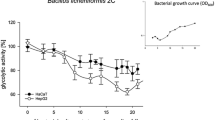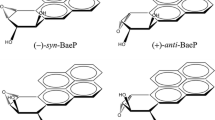Summary
Studies of the tumorigenicity of 6-halogenated derivatives of benzo[a]pyrene (BP) can provide evidence about the role of the 6 position in the carcinogenic activation of BP. Female Swiss and A-strain mice were treated on the skin with BP, 6-fluorobenzo[a]pyrene (6-FBP), 6-chlorobenzo[a]pyrene (6-C1BP), 6-bromobenzo[a]pyrene (6-BrBP) and 6-iodobenzo[a]pyrene (6-IBP) by repeated application, and in some cases by initiation-promotion. While BP was more potent than 6-FBP, only these two compounds exhibites tumor-initiating and carcinogenic activity in mouse skin. Female Sprague-Dawley rats were treated with BP, 6-FBP, 6-C1BP, and 6-BrBP by intramammillary injection. BP and 6-FBP induced high levels of mammary epithelial tumors and fibrosarcomas. 6-C1BP elicited only a high percentage of fibrosarcomas, whereas 6-BrBP induced a few adenocarcinomas. These results indicate that chloro or bromo substitution at C-6 in BP reduces or eliminates carcinogenic activity. Conversely, 6-FBP, from which the fluoro substituent has been chemically and metabolically removed by one-electron oxidation, displays a moderate carcinogenic acitivity which is consistent with activation by either one-electron oxidation or monooxygenation.
Similar content being viewed by others
Abbreviations
- BP:
-
benzo[a]pyrene
- 6-BrBP:
-
6-bromobenzo[a]pyrene
- 6-C1BP:
-
6-chlorobenzo[a]pyrene
- 6-FBP:
-
6-fluorobenzo[a]pyrene
- 6-IBP:
-
6-iodobenzo[a]pyrene
- 6-OAcBP:
-
6-acetoxybenzo[a]pyrene
- PAH:
-
polycyclic aromatic hydrocarbons
References
Blackburn GM, Taussig PE, Will JP (1974) Binding of benzo[a]pyrene to DNA investigated by tritium displacement. J Chem Soc Chem Commun 907–908
Buening M, Levin W, Wood AW, Chang RL, Agranat I, Rabinovitz M, Buhler DR, Mah HD, Hernandez O, Simpson RB, Jerina DM, Conney AH, Miller EC, Miller JA (1983) Fluorine substitution as a probe for the role of the 6-position of benzo[a]pyrene in carcinogenesis. J Natl Cancer Inst 71:309–315
Buhler DR, Unlü F, Thakker DR, Slaga TJ, Conney AH, Wood AW, Chang RL, Levin W, Jerina DM (1983) Effect of a 6-fluoro substituent on the metabolism and biological activity of benzo[a]pyrene. Cancer Res 43:1541–1549
Cavalieri E, Auerbach R (1974) Reactions between activated benzo[a]pyrene and nucleophilic compounds with possible implications on the mechanism of tumor initiation. J Natl Cancer Inst 53:393–397
Cavalieri E, Rogan E (1984) One-electron and two-electron oxidation in aromatic hydrocarbon carcinogenesis. In: Pryor WA (ed) Free radicals in biology, vol VI. Academic Press, New York, pp 323–397
Cavalieri E, Rogan E (1985) Role of radical cations in aromatic hydrocarbon carcinogenesis. Environ Health Perspect 64:69–84
Cavalieri E, Roth R, Grandjean C, Althoff J, Patil K, Liakus S, Marsh S (1978) Carcinogenicity and metabolism of 6-substituted benzo[a]pyrene derivatives on mouse skin. Chem Biol Interact 22:53–67
Cavalieri EL, Rogan EG, Roth RW, Saugier RK, Hakam A (1983) The relationship between ionization potential and horseradish peroxidase/hydrogen peroxide-catalyzed binding of aromatic hydrocarbons to DNA. Chem Biol Interact 47:87–109
Cavalieri E, Rogan E, Cremonesi P, Devanegan P (1988a) Radical cations as precursors in the metabolic formation of quinones from benzo[a]pyrene and 6-fluorobenzo[a]pyrene: fluoro substitution as a probe for one-election oxidation in aromatic substrates. Biochem Pharmacol (in press)
Cavalieri E, Rogan E, Higginbotham S, Cremonesi P, Salmasi S (1988b) Tumor-initiating activity in mouse skin and carcinogenicity in rat mammary gland of fluorinated derivatives of benzo[a]pyrene and 3-methylcholanthrene. J Cancer Res Clin Oncol 114:16–22
Conney AH (1982) Induction of microsomal enzymes by foreign chemicals and carcinogenesis by polycyclic aromatic hydrocarbons: G.H.A. Clowes Memorial Lecture. Cancer Res 42:4875–4917
Cremonesi P, Cavalieri E, Rogan E (1986) One-electron oxidation of 6-substituted benzo[a]pyrenes by manganic acetate. Abstracts of the 192nd American Chemical Society National Meeting, Organic Section, no 11
Fu PP, Yang SK (1982) Stereoselective metabolism of 6-bromobenzo[a]pyrene by rat liver microsomes: Absolute configuration of trans-dihydrodiol metabolites. Biochem Biophys Res Commun 109:927–934
Jeftic L, Adams RN (1970) Electrochemical oxidation pathways of benzo[a]pyrene. J Am Chem Soc 92:1332–1337
Johnson MD, Calvin M (1973) Induced nucleophilic substitution in benzo[a]pyrene. Nature 241:271–272
Nonhebel DC (1963) 9-Chloroanthracene. In: McKusick DM (ed) Organic synthesis, vol 43. Wiley, New York, pp 15–17
Rochlitz J (1967) Neue Reaktionen der carcinogenen Kohlenwasserstoffe. II. Tetrahedron 23:3043–3048
Rogan E, Roth R, Katomski P, Benderson J, Cavalieri E (1978) Binding of benzo[a]pyrene at the 1,3,6 positions to nucleic acids in vivo on mouse skin and in vitro with rat liver microsomes and nuclei. Chem Biol Interact 22:35–51
Rogan EG, Roth R, Cavalieri E (1980) Manganic acetate and horseradish peroxidase/hydrogen peroxide: In vitro models of activation of aromatic hydrocarbons by one-electron oxidation. In: Bjørseth A, Dennis AJ (eds) Polynuclear aromatic hydrocarbons: chemistry and biological effects. Battelle Press, Columbus, Ohio, pp 259–265
Sims P, Grover PL (1981) Involvement of dihydrodiols and diol epoxides in the metabolic activation of polycyclic aromatic hydrocarbons other than benzo[a]pyrene. In: Gelboin HV, Ts'o POP (eds) Polycyclic hydrocarbons and cancer, vol 3. Academic Press, New York, pp 117–181
Sullivan PD, Ocasio IJ, Chen X, Bannoura F (1986) EPR and ENDOR studies of 6-stubstituted benzo[a]pyrene cation radicals. J Am Chem Soc 108:257–260
Thakker DR, Yagi H, Sayer JM, Kapur U, Levin W, Chang RL, Wood AW, Conney AH, Jerina DM (1984) Effects of a 6-fluoro substituent on the metabolism of benzo[a]pyrene 7,8-dihydrodiol to bay-region diol epoxides by rat liver enzymes. J Biol Chem 259:11249–11256
Wilk M, Girke W (1972) Reactions between benzo[a]pyrene and nucleobases by one-electron oxidation. J Natl Cancer Inst 49:1585–1597
Author information
Authors and Affiliations
Additional information
Supported by Public Health Service contract NO1 CPO5620 and grants 1 RO1 CA32376 and Laboratory Cancer Research Center Core Grant CA36727 from the National Cancer Institute
Rights and permissions
About this article
Cite this article
Cavalieri, E., Rogan, E., Cremonesi, P. et al. Tumorigenicity of 6-halogenated derivatives of benzo[a]pyrene in mouse skin and rat mammary gland. J Cancer Res Clin Oncol 114, 10–15 (1988). https://doi.org/10.1007/BF00390479
Received:
Accepted:
Issue Date:
DOI: https://doi.org/10.1007/BF00390479




